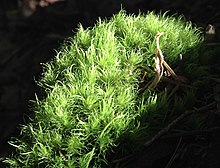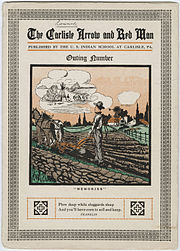The biophilia hypothesis suggests that humans possess an innate tendency to seek connections with nature and other forms of life. Edward O. Wilson introduced and popularized the hypothesis in his book, Biophilia (1984). He defines biophilia as "the urge to affiliate with other forms of life".
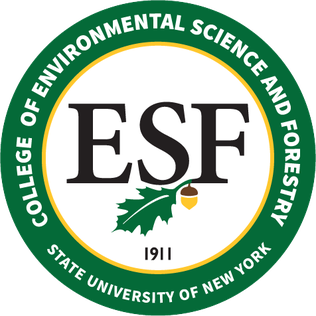
The State University of New York College of Environmental Science and Forestry (ESF) is a public research university in Syracuse, New York focused on the environment and natural resources. It is part of the State University of New York (SUNY) system. ESF is immediately adjacent to Syracuse University, within which it was founded, and with which it maintains a special relationship. It is classified among "R2: Doctoral Universities – High research activity".
Spiritual ecology is an emerging field in religion, conservation, and academia that proposes that there is a spiritual facet to all issues related to conservation, environmentalism, and earth stewardship. Proponents of spiritual ecology assert a need for contemporary nature conservation work to include spiritual elements and for contemporary religion and spirituality to include awareness of and engagement in ecological issues.

Ecological restoration, or ecosystem restoration, is the process of assisting the recovery of an ecosystem that has been degraded, damaged, or destroyed. It is distinct from conservation in that it attempts to retroactively repair already damaged ecosystems rather than take preventative measures. Ecological restoration can reverse biodiversity loss, combat climate change, and support local economies. Habitat restoration involves the deliberate rehabilitation of a specific area to reestablish a functional ecosystem. To achieve successful habitat restoration, it's essential to understand the life cycles and interactions of species, as well as the essential elements such as food, water, nutrients, space, and shelter needed to support species populations. When it's not feasible to restore habitats to their original size or state, designated areas known as wildlife corridors can be established. These corridors connect different habitats and open spaces, facilitating the survival of species within human-dominated landscapes. For instance, marshes serve as critical stopover sites for migratory birds, wildlife overpasses enable animals to safely cross over highways, and protected riparian zones within urban settings provide necessary refuges for flora and fauna. The United Nations named 2021-2030 the Decade on Ecosystem Restoration.

Systems ecology is an interdisciplinary field of ecology, a subset of Earth system science, that takes a holistic approach to the study of ecological systems, especially ecosystems. Systems ecology can be seen as an application of general systems theory to ecology. Central to the systems ecology approach is the idea that an ecosystem is a complex system exhibiting emergent properties. Systems ecology focuses on interactions and transactions within and between biological and ecological systems, and is especially concerned with the way the functioning of ecosystems can be influenced by human interventions. It uses and extends concepts from thermodynamics and develops other macroscopic descriptions of complex systems.

Hierochloe odorata or Anthoxanthum nitens is an aromatic herb native to northern Eurasia and North America. It is considered sacred by many Indigenous peoples in Canada and the United States. It is used as a smudge in herbal medicine and in the production of distilled beverages. It owes its distinctive sweet scent to the presence of coumarin.
Charles A. S. Hall is an American systems ecologist and ESF Foundation Distinguished Professor at State University of New York in the College of Environmental Science & Forestry.

David Abram is an American ecologist and philosopher best known for his work bridging the philosophical tradition of phenomenology with environmental and ecological issues. He is the author of Becoming Animal: An Earthly Cosmology (2010) and The Spell of the Sensuous: Perception and Language in a More-than-Human World (1996), for which he received the Lannan Literary Award for Nonfiction. Abram is founder and creative director of the Alliance for Wild Ethics (AWE); his essays on the cultural causes and consequences of ecological disarray have appeared often in such journals as the online magazine Emergence, Orion, Environmental Ethics, Parabola, Tikkun and The Ecologist, as well as in numerous academic anthologies.

Turtle Island is a name for Earth or North America, used by some Indigenous peoples, as well as by some Indigenous rights activists. The name is based on a creation story common to several Indigenous peoples of the Northeastern Woodlands of North America.
Traditional ecological knowledge (TEK) describes indigenous and other traditional knowledge of local resources. As a field of study in Northern American anthropology, TEK refers to "a cumulative body of knowledge, belief, and practice, evolving by accumulation of TEK and handed down through generations through traditional songs, stories and beliefs. It is concerned with the relationship of living beings with their traditional groups and with their environment." Indigenous knowledge is not a universal concept among various societies, but is referred to a system of knowledge traditions or practices that are heavily dependent on "place". Such knowledge is used in natural resource management as a substitute for baseline environmental data in cases where there is little recorded scientific data, or may complement Western scientific methods of ecological management.
Deep ecology is an environmental philosophy that promotes the inherent worth of all living beings regardless of their instrumental utility to human needs, and the restructuring of modern human societies in accordance with such ideas.

Diana Harrison Wall was an American environmental scientist and soil ecologist. She was the founding director of the School of Global Environmental Sustainability, a distinguished biology professor, and senior research scientist at the Natural Resource Ecology Laboratory at Colorado State University. Wall investigated ecosystem processes, soil biodiversity and ecosystem services. Her research focused on the Antarctic McMurdo Dry Valleys and its Wall Valley was named after her. Wall was a globally recognized leader and speaker on life in Antarctica and climate change.
Jan Salick is an American botanist who researches the interaction between humans and plants (ethnobotany) and conservation biology. Her specialisms include alpine environments, climate change, indigenous peoples and traditional knowledge. She is a past-president of the Society for Economic Botany and holds their Distinguished Economic Botanist award. She is also Fellow of the American Association for the Advancement of Science and received the Fairchild Medal for Plant Exploration. In 2019 she retired as Senior Curator of Ethnobotany at the Missouri Botanical Garden, and now has emerita status.

Braiding Sweetgrass: Indigenous Wisdom, Scientific Knowledge, and the Teachings of Plants is a 2013 nonfiction book by Potawatomi professor Robin Wall Kimmerer, about the role of Indigenous knowledge as an alternative or complementary approach to Western mainstream scientific methodologies.
Karin Limburg is a professor in the department of Environmental and Forest Biology at SUNY-ESF.
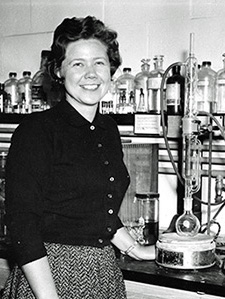
Jean H. Langenheim was an American plant ecologist and ethnobotanist, highly respected as an eminent scholar and a pioneer for women in the field. She has done field research in arctic, tropical, and alpine environments across five continents, with interdisciplinary research that spans across the fields of chemistry, geology, and botany. Her early research helped determine the plant origins of amber and led to her career-long work investigating the chemical ecology of resin-producing trees, including the role of plant resins for plant defense and the evolution of several resin-producing trees in the tropics. She wrote what is regarded as the authoritative reference on the topic: Plant Resins: Chemistry, Evolution, Ecology, and Ethnobotany, published in 2003.

Narel Y. Paniagua-Zambrana is a Bolivian ethnobotanist. She investigates the use and protection of traditional knowledge of plants in indigenous communities, particularly in the Bolivian Andes. She is currently an Associated Researcher at the Herbario Nacional de Bolivia, Instituto de Ecología, Universidad Mayor de San Andres in Bolivia. Her goal is giving them the knowledge to participate in decision-making on the conservation of their intangible cultural heritage.

Anna Traveset is a Spanish ecologist, particularly known for her work on ecological interactions between plants and animals, especially on islands.
Indigenous science is the application and intersection of Indigenous knowledge and science. In ecology, this is sometimes termed traditional ecological knowledge. Indigenous science refers to the knowledge systems and practices of Indigenous peoples, which are rooted in their cultural traditions and relationships to their indigenous context. It follows the same methods of Western science including : observation, prediction, interpretation, questioning. The knowledge and information that Indigenous people have was often devalued by white European and American scientists and explorers. However, there has been a growing recognition of the benefits of incorporating Indigenous perspectives and knowledge particularly in fields such as ecology and environmental management.
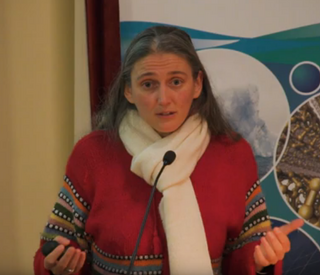
Monica Gagliano is an ecologist known for expanding the field of biological research into the intelligence of plants.

